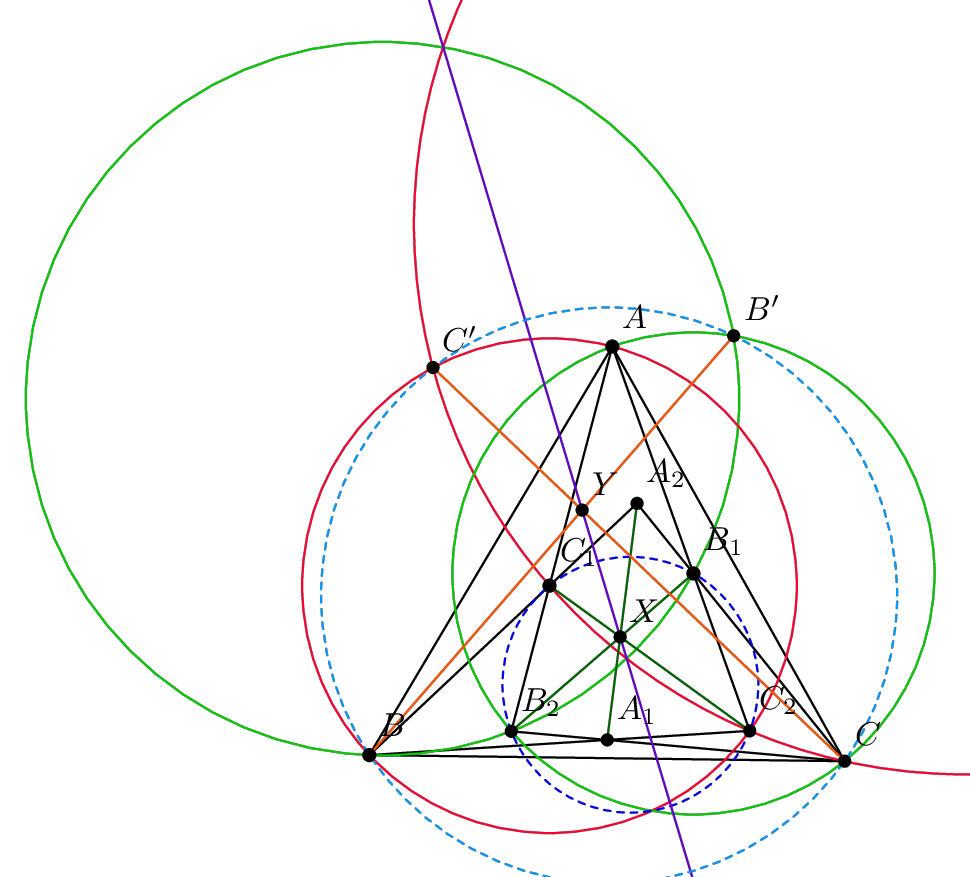Solution 1
Let
 ,
,  ,
, and
 ,
, so the condition becomes
 .
. Note that
 ,
, so

is the circumcenter of
 .
. Similarly,

and

are the circumcenters of

and
 .
. Furthermore,
 .
. Thus,

is cyclic. Similarly,

and

are cyclic. Let
 ,
,  ,
, and

be the circumcircles of
 ,
,  ,
, and
 .
. As
 ,
, we have that

is not cyclic and
 ,
,  ,
, and

are distinct. By the radical axis theorem,
 ,
,  ,
, and

then concur at a point
 .
.
Let

denote the power of point

to circle
 .
. We now compute
 .
. Let

meet

at

and

meet

at
 .
. We have that

and
 ,
, so
 .
. Similarly,
 ,
,  ,
, and
 .
. It follows by the law of sines on triangles

and

that
 .
. Thus,
 .
.
By computing the analogous expressions for the other vertices, we conclude that
 .
.
To conclude, recall the coaxial lemma: given two circles

and

and a constant
 ,
, the locus of points

for which

is a circle coaxial to

and
 .
. Hence, the circumcircle of

is the locus of points

with
 ,
, and the analogous statements hold for the other vertices. The angle condition implies that segments
 ,
,  ,
, and

intersect, so the circumcircles of
 ,
,  ,
, and

pairwise intersect at two points. It follows that the circumcircles of

and

intersect at points

and

satisfying

and

for
 .
. But this then implies that

for
 ,
, so

and

both lie on the circumcircle of
 ,
, as desired.
Solution 2
Let

be
 .
. Let

be the power of an arbitrary point

with respect to
 .
. Let
 .
. Define
 ,
, 
and

similarly. The angle condition becomes
 .
. An angle chase gives that
![\[\angle BA_2C = 60^\circ+\beta+\gamma=90^\circ-\alpha=\frac{1}{2}\angle BA_1C,\]](https://latex.artofproblemsolving.com/d/2/7/d279818c70b6d5ca642e10033dc9b50a6e46400f.png)
so

is the center of
 .
. We then further have
 .
.
We now compute each of

evaluated at each of
 .
. It's direct that
 .
. It suffices to compute

as the remaining formulas follow from symmetry. Let

meet

at
 .
. We have

By LOS on

then
 ,
,
![\[f_A(B) = BT \cdot BA = \left(BA_2 \cdot \frac{\sin \angle BA_2 T}{\sin \angle BTA_2}\right) BA =\left( BC \cdot \frac{\sin(BCA_2)}{\sin(BA_2C)} \cdot \frac{\sin( BA_2 T)}{\sin (BTA_2)} \right) BA =s^2 \frac{\sin(60^\circ-\beta)\sin(180^\circ-\beta)}{\sin(90^\circ+\alpha)\sin(\beta-\gamma)}, \]](https://latex.artofproblemsolving.com/c/7/d/c7d2d4d194b607510152b0b5c7d0cc0bf9fcccc8.png)
where

is the side length of
 .
. Now we have all the powers!! The key claim that we've been building up to is the following:
Lemma: If
 ,
, and

are defined similarly, then we have

and
 .
Proof:
.
Proof: If we write any of the functions

in coordinates, it's

plus some linear equation. It's straightforward to check that

(note
 )
), so

is a linear function. Our previous power of a point computation gives

when

is any of
 ,
,  ,
, or
 .
. The only linear function that's zero at three noncollinear points is the zero function, so

for all
 .
. 
Now,

is the linear equation of the radical axis of

and
 .
. We also have the analogous property for
 .
. But we also have
 ,
, so these are the same line, as desired.

